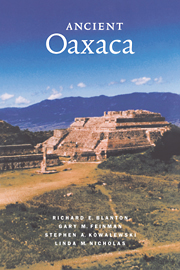Book contents
1 - Introduction: Mesoamerica and its pre-Hispanic civilization
Published online by Cambridge University Press: 05 June 2012
Summary
Some 2,500 years ago in the Valley of Oaxaca, in what is now southern Mexico, a profound social and cultural transformation resulted in the region's first state. This polity, centered at Monte Albán, represented a form of government far more complex than any that had developed in the region before. Like only a few other states in the world, it developed in a primary or indigenous context (i.e., without the influence of a preexisting state). Our aim here is to explore how and why this fundamentally new kind of institution developed. Such questions have a long intellectual history, and the origins of primary states remain a key problem for contemporary anthropological archaeology (e.g., Sanders and Price 1968; Service 1975; Wright 1986).
In developing this early state, the pre-Hispanic ancestors of today's inhabitants of the Valley of Oaxaca fashioned an institution that eventually equaled the scale and complexity of other early states in ancient Egypt, Mesopotamia, and North China, as well as other Mesoamerican states such as those of the Aztec and the Maya. Mesoamerica, which includes southern Mexico and adjacent parts of western Central America, was the setting for one of two native urban civilizations in the Americas – the other being the Andean civilization of the Inca and their predecessors.
Through their development of the state as a governing institution, the early inhabitants of the Valley of Oaxaca made a significant contribution to the growth of ancient Mesoamerican civilization.
- Type
- Chapter
- Information
- Ancient Oaxaca , pp. 1 - 21Publisher: Cambridge University PressPrint publication year: 1999

